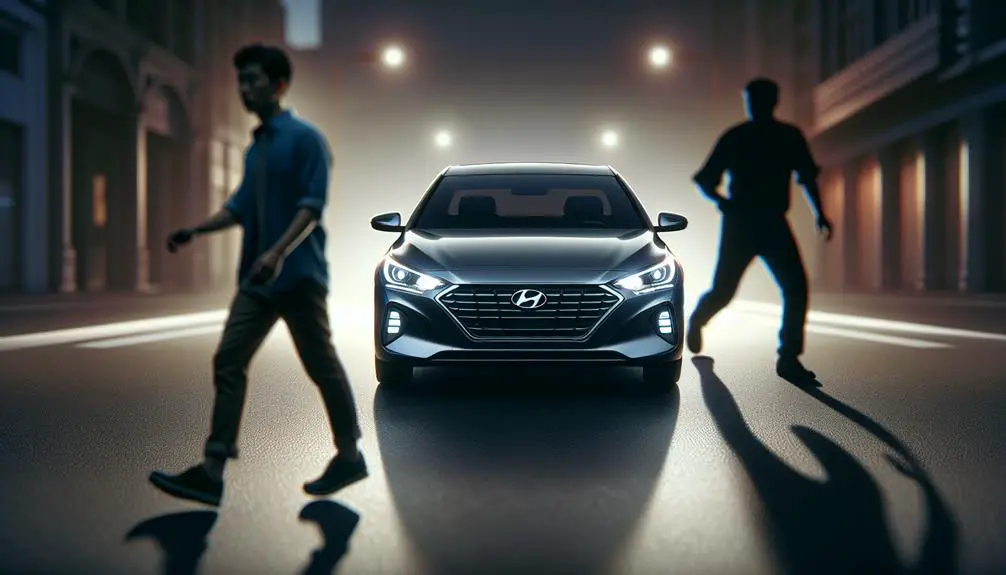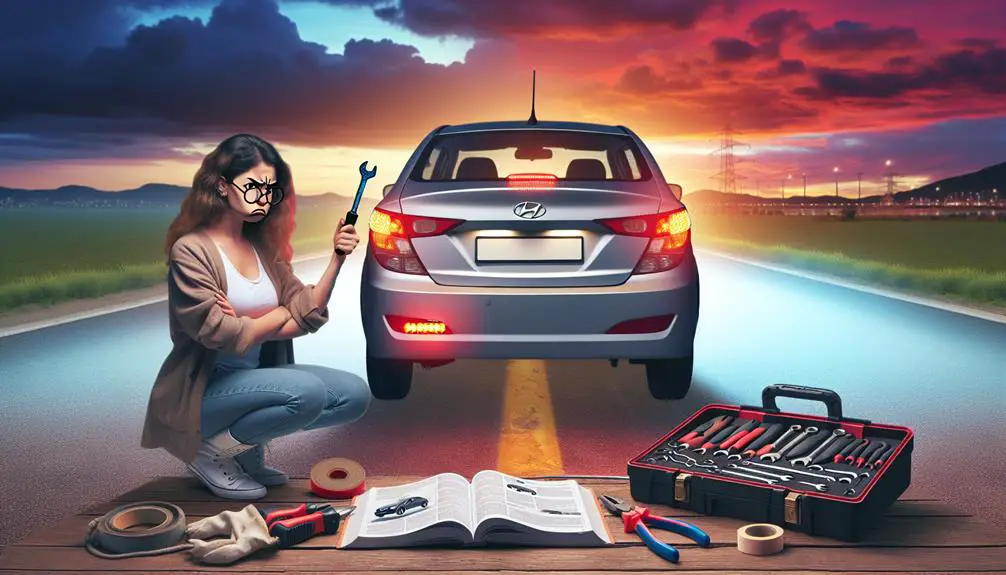Hyundai has experienced a widespread brake light failure issue that affects nearly 20% of vehicles manufactured in the past decade. This problem poses significant safety risks to drivers and other road users.
It is crucial for Hyundai to address this issue promptly and effectively to ensure the safety of all vehicles on the road.
The Safety Implications

The malfunctioning of Hyundai's brake lights poses a significant risk to road safety, potentially leading to catastrophic accidents. When you're driving, you rely on the brake lights of vehicles ahead to alert you when they're slowing down or stopping. Without this critical signal, you're at a higher risk of rear-ending the car in front of you, especially if you're driving at high speeds or in heavy traffic.
Furthermore, brake light issues don't just endanger the driver of the affected Hyundai; they compromise the safety of everyone on the road. Bikers, pedestrians, and drivers of other vehicles all depend on clear signals to navigate traffic safely. When these signals fail, the risk of collisions skyrockets, not just for rear-end collisions but for cross-traffic accidents as well.
You also need to take into account the broader implications. Insurance rates could spike because of the increased risk of accidents. Traffic flow might be disrupted more frequently, leading to congestion and delays. Emergency response times could be affected if accidents become more common. It's a domino effect that starts with something as seemingly simple as a brake light but can ripple out to affect different aspects of road safety and efficiency.
It's vital to grasp the gravity of this issue. It's not just about inconvenience or vehicle repairs. It's about protecting lives and maintaining the safety and smooth operation of our roadways. You're a part of this system every time you get behind the wheel, and grasping the risks helps everyone make safer choices on the road.
Affected Models and Years
Identifying the specific Hyundai models and years impacted by brake light issues is important for ensuring your vehicle remains safe on the road. While Hyundai has been recognized for its commitment to quality and innovation, certain models have encountered challenges with their brake light systems. These problems can range from brake lights failing to illuminate when the brake pedal is pressed to staying on even when the pedal isn't engaged. Recognizing if your car is among those affected is a critical step in addressing the problem promptly.
The models and years that have been notably affected include:
- Hyundai Sonata (2011-2014): This model range has seen issues where the brake lights may not illuminate during braking or may stay illuminated, confusing other drivers.
- Hyundai Santa Fe (2013-2015): Owners have reported instances where the brake lights remain on, which can drain the battery and create a safety hazard.
- Hyundai Elantra (2011-2013): Similar to the Sonata, the Elantra has faced problems with brake lights not activating when the brake pedal is pressed.
If your Hyundai falls within these models and years, it's important to pay attention to your brake light functionality. Regular checks can help identify any issues early on, and addressing them promptly can prevent potential safety hazards. Additionally, staying informed about any recalls or service bulletins issued by Hyundai for your specific model can help ensure that your vehicle remains safe and reliable on the road.
Owner Experiences

Grasping which Hyundai models and years are affected by brake light issues is just the initial step; hearing from owners about their real-world experiences offers further insight into the problem's impact.
You've likely heard murmurs or read online forums where Hyundai owners express their frustrations. Many recount instances where their brake lights failed to illuminate when pressing the brake pedal, leading to near misses or, in unfortunate cases, actual collisions. These stories aren't just isolated incidents; they weave a larger narrative of concern and the need for resolution.
Imagine you're driving, relying on your vehicle to signal others of your intent to slow down or stop, only to find out later that the very mechanism designed to keep you safe didn't activate. This realization isn't just alarming; it's a call to action to seek a fix before worse outcomes unfold.
Owners have shared their experiences in trying to resolve these issues, often involving trips to the dealership or local mechanic. The frustration compounds when they're told that parts are on backorder or, even more distressingly, when the problem recurs after supposed fixes. You might find yourself nodding in agreement, having faced similar runarounds.
The collective voice of Hyundai owners experiencing brake light problems is loud and clear. It's not just about the inconvenience of repairs; it's the underlying concern for safety on the road. As you navigate through these shared experiences, you become part of a community seeking not just answers but action to ensure such issues are squarely addressed and rectified.
Are Tail Light Issues Related to the Brake Light Problem in Hyundai Vehicles?
Yes, common Hyundai tail light issues can often be related to brake light problems. Faulty wiring, burnt-out bulbs, or a malfunctioning brake light switch can all contribute to issues with both the tail lights and brake lights in Hyundai vehicles. It’s important to address these problems promptly for safety reasons.
Hyundai's Response
Hyundai has taken steps to address the widespread brake light issues reported by owners, launching recall initiatives and offering repair services to relieve safety concerns. Recognizing the potential dangers posed by malfunctioning brake lights, the company's response highlights its commitment to customer safety and satisfaction.
You've likely heard about the brake light problem affecting numerous Hyundai models. It's a situation that raised eyebrows and concerns among owners and safety regulators alike. Hyundai's proactive approach to resolving this issue showcases the manufacturer's dedication to rectifying problems that could compromise the safety of its vehicles and their occupants. Here's what you need to know about Hyundai's response:
- Thorough Recall Campaigns: Hyundai has initiated several recall campaigns to address the defective brake light components. These campaigns target specific models and manufacturing years known to be affected by this issue.
- Free Repair Services: For owners of affected vehicles, Hyundai dealerships offer free repair services. This includes the replacement of faulty brake light switches to make sure that the brake lights function correctly, enhancing safety on the road.
- Customer Communication: Hyundai has made efforts to reach out to owners of potentially affected vehicles through different channels. This includes direct mail, email notifications, and announcements on their official website, making sure that owners are informed and aware of the steps they need to take.
Hyundai's response to the brake light problem underlines the company's resolve to uphold high safety standards and customer trust. By addressing this issue head-on, Hyundai aims to make sure that its vehicles remain safe and reliable for all road users.
Remediation Steps

What steps should you take if your Hyundai is part of the recall for the brake light issue? First off, don't panic. Hyundai's taking responsibility and has laid out a clear path for fixing the problem at no cost to you. Here's what you need to do.
To start, check if your vehicle's model and year are listed in the recall notice. Hyundai's official website and the National Highway Traffic Safety Administration (NHTSA) site are two places where you can find this information. If your car's on the list, the next step is to contact your local Hyundai dealership.
They'll arrange an appointment for you to bring in your car. Make sure you do this promptly. The repair itself shouldn't take long, but the peace of mind knowing your brake lights work as they should is invaluable.
Here's a brief outline to help you navigate the process:
| Step | Action | Expected Outcome |
|---|---|---|
| 1 | Confirm Recall | Validate your Hyundai is affected |
| 2 | Reach out to Dealership | Schedule a repair appointment |
| 3 | Repair Service | Dealership fixes the brake light issue |
| 4 | Subsequent Check | Make sure no further issues arise |
To end, keep an eye out for any communication from Hyundai regarding the recall. They might provide updates or further instructions. This situation underscores the importance of maintaining up-to-date contact information with your vehicle manufacturer. Remember, staying informed and proactive is key to ensuring your safety on the road.
Conclusion
You've likely heard about the Hyundai brake light problem affecting different models and years, posing significant safety concerns. From the shared experiences of owners facing unexpected issues to Hyundai's efforts to address the problem, it's clear that action is vital.
Hyundai has committed to remedying the situation, offering solutions to make sure your safety on the road. It's important to stay informed and take advantage of the remediation steps provided to protect yourself and your loved ones.